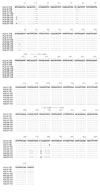Abstract
Pneumocystis jiroveci (formerly Pneumocystis carinii f. sp. hominis) is one of the causative agents of the most serious fungal respiratory infections in immuno-compromised patients. Although P. jiroveci infections have been increasing, there are few data on the P. jiroveci genotypes in Korea. This study was performed to investigate the genetic diversity of P. jiroveci detected from clinical specimens. Twenty-one P. jirovecipositive respiratory samples detected by polymerase chain reaction were collected from a tertiary-care hospital in Seoul between Jan 2003 and Aug 2006. Internal Transcribed Spacer (ITS) sequence analysis
was performed by direct sequencing. Only 9 specimens were appropriate for sequence analysis. Twelve specimens, however, showed mixed sequences by direct sequencing. Three ITS genotypes of P. jiroveci were found. There is limited genetic diversity of ITS genes of P. jiroveci from clinical isolates analyzed in this study. The present ITS gene analysis suggests that most of P. jiroveci isolates may have genetic similarity among patients in Korea.
Figures and Tables
 | Fig. 1Partial nucleotide sequences of ITS1-5.8S rRNA-ITS2 of nine P. jiroveci strains from clinical specimens at a tertiarycare hospital in Seoul, Korea. A total of three ITS types in nine P. jiroveci strains have been found. Mixed ITS types (n=12) could not be analyzed in this study. Hyphens are introduced for sequence comparison, indicating missing nucleotides. |
References
1. Stringer JR, Beard CB, Miller RF, Wakefield AE. A new name (Pneumocystis jiroveci) for Pneumocystis from humans. Emerg Infect Dis. 2002. 8:891–896.
2. Lu JJ, Chen CH, Bartlett MS, Smith JW, Lee CH. Comparison of six different PCR methods for detection of Pneumocystis carinii. J Clin Microbiol. 1995. 33:2785–2788.

3. Miller RF, Ambrose HE, Wakefield AE. Pneumocystis carinii f. sp. hominis DNA in immunocompetent health care workers in contact with patients with P. carinii pneumonia. J Clin Microbiol. 2001. 39:3877–3882.

4. Morris A, Wei K, Afshar K, Huang L. Epidemiology and clinical significance of pneumocystis colonization. J Infect Dis. 2008. 197:10–17.

5. Chung BS, Pars YK, Huh S, Yu JR, Kim J, Shi X, et al. Genetic heterogeneity of Pneumocystis carinii from rats of several regions and strains. Korean J Parasitol. 2000. 38:151–158.

6. Lee CH, Helweg-Larsen J, Tang X, Jin S, Li B, Bartlett MS, et al. Update on Pneumocystis carinii f. sp. hominis typing based on nucleotide sequence variations in internal transcribed spacer regions of rRNA genes. J Clin Microbiol. 1998. 36:734–741.

7. Tsolaki AG, Beckers P, Wakefield AE. Pre-AIDS era isolates of Pneumocystis carinii f. sp. hominis
: high genotype similarity with contemporary isolates. J Clin Microbiol. 1998. 36:90–93.

8. Pai HJ. Comparison of nucleotide sequence of thymidylate synthase from human-derived Pneumocystis carinii with that from rat-derived Pneumocystis carinii. Korean J Infect Dis. 1995. 27:349–354.
9. Latouche S, Ortona E, Mazars E, Margutti P, Tamburrini E, Siracusano A, et al. Biodiversity of Pneumocystis carinii hominis>: typing with different DNA regions. J Clin Microbiol. 1997. 35:383–387.

10. Hsueh JY, Bohm RP Jr, Didier PJ, Tang X, Lasbury ME, Li B, et al. Internal transcribed spacer regions of rRNA genes of Pneumocystis carinii from monkeys. Clin Diagn Lab Immunol. 2001. 8:503–508.

11. Siripattanapipong S, Worapong J, Mungthin M, Leelayoova S, Tan-ariya P. Genotypic study of Pneumocystis jiroveci in human immunodeficiency virus-positive patients in Thailand. J Clin Microbiol. 2005. 43:2104–2110.

12. Cho SR, Park YG, Moon HN, Lee SH, Hong ST. Karyotypes of Pneumocystis carinii derived from several mammals. Korean J Parasitol. 1999. 37:271–275.

13. Hall TA. BioEdit: a user-friendly biological sequence alignment editor and analysis program for Windows 95/98/NT. Nucl Acids Symp Ser. 1999. 41:95–98.
14. Tsolaki AG, Miller RF, Underwood AP, Banerji S, Wakefield AE. Genetic diversity at the internal transcribed spacer regions of the rRNA operon among isolates of Pneumocystis carinii from AIDS patients with recurrent pneumonia. J Infect Dis. 1996. 174:141–156.

15. Robberts FJ, Liebowitz LD, Chalkley LJ. Genotyping and coalescent phylogenetic analysis of Pneumocystis jiroveci from South Africa. J Clin Microbiol. 2004. 42:1505–1510.

16. de Boer MG, Bruijnesteijn van Coppenraet LE, Gaasbeek A, Berger SP, Gelinck LB, van Houwelingen HC, et al. An outbreak of Pneumocystis jiroveci pneumonia with 1 predominant genotype among renal transplant recipients: interhuman transmission or a common environmental source? Clin Infect Dis. 2007. 44:1143–1149.





 PDF
PDF ePub
ePub Citation
Citation Print
Print



 XML Download
XML Download